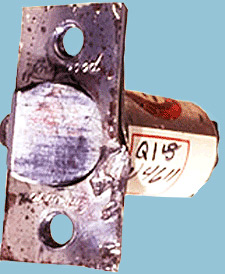- 01: Introduction
- 02: History
- 03: Propellants, Firearms, and Ammunition Development
- 04: Modern Firearms Manufacture
- 05: Small Arms Ammunition
- 06: Evidence Handling Procedures
- Introduction
- Objectives
- AFTE Knowledge and Ability Factors
- Types of Evidence
- Associative Evidence
- The Crime Scene
- Evidence Submission
- Laboratory Evidence Handling
- Case Tracking Within the Laboratory
- Firearm and Toolmark Examination Considerations
- Selected Bibliography
- 07: Equipment and Instrumentation
- 08: Examination of Firearms
- 09: Cartridge and Shotshell Examination
- 10: Characterization and Evaluation of Fired Projectiles
- 11: Bullet Comparison and Identification
- 12: Gunshot Residue and Distance Determination
- 13: Toolmark Identification
- 14: Communicating Results
- Resources


Toolmarked Items
Home > Evidence Handling Procedures > The Crime Scene > Collection of Evidence > Toolmarked Items
Although toolmarked items come in many shapes and sizes, most can be easily collected, marked, and documented. Some toolmarked items require different collection methods. For example, a bank’s massive safe door cannot be removed.
Small toolmark evidence items may include
- cut alarm wires,
- lock shackles,
- entryway doorknobs,
- telephone lines,
- sections of power transmission lines,
- links from a chain link fence.

Labeled toolmarked evidence
The questioned (evidence) toolmarks should be protected. These items should be wrapped in heavy paper to avoid damaging the marks or losing trace evidence. A tag or sturdy label containing the required identifying data should be attached at a point well away from the questioned marks.
If it is necessary to remove an item from its source, as is often the case, the location where the evidence was separated from that source should be labeled. If this is not done, there is the likelihood of doubling the work of the toolmark examiner, particularly in the case of wires, power lines, and chain links. For example, submitted unlabeled wires would require the examination of both ends; properly labeled wires would require only the examination of the labeled end. The questioned items should also be well protected from contact with the suspect tools.
A large, freestanding floor safe is a classic example of a large toolmark evidence item that is difficult, but not impossible, to move. Because of the special handling requirements and shipping expense necessary to protect toolmarks on large items, they are frequently delivered to the laboratory on a pallet.
Permission may be required to cut out any microscopic marks of value. Depending on laboratory policy, the examiner may need to contact the investigator to acquire permission. If the microscopic marks cannot be cut out, casting material must be used to preserve them for comparison purposes.
Large immovable objects or objects that cannot be taken out of service must be initially examined on-site for trace evidence and a cast made of the marks for later comparison at the laboratory. Agency policy would dictate whether investigators, crime scene technicians, or laboratory examiners go to the site to make the casts. As always, trace evidence and the careful marking and packaging of the casts are critical concerns. As the cast is hardening, it is convenient to insert the identifying information in the casting material.




